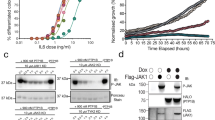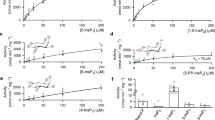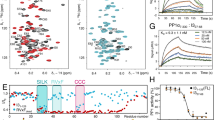Abstract
The crystal structure of the catalytic domain from the MAPK phosphatase Pyst1 (Pyst1–CD) has been determined at 2.35 Å. The structure adopts a protein tyrosine phosphatase (PTPase) fold with a shallow active site that displays a distorted geometry in the absence of its substrate with some similarity to the dual–specificity phosphatase cdc25. Functional characterization of Pyst1–CD indicates it is sufficient to dephosphorylate activated ERK2 in vitro. Kinetic analysis of Pyst1 and Pyst1–CD using the substrate p–nitrophenyl phosphate (pNPP) reveals that both molecules undergo catalytic activation in the presence of recombinant inactive ERK2, switching from a low– to high–activity form. Mutation of Asp 262, located 5.5 Å distal to the active site, demonstrates it is essential for catalysis in the high–activity ERK2–dependent conformation of Pyst1 but not for the low–activity ERK2–independent form, suggesting that ERK2 induces closure of the Asp 262 loop over the active site, thereby enhancing Pyst1 catalytic efficiency.
This is a preview of subscription content, access via your institution
Access options
Subscribe to this journal
Receive 12 print issues and online access
$189.00 per year
only $15.75 per issue
Buy this article
- Purchase on Springer Link
- Instant access to full article PDF
Prices may be subject to local taxes which are calculated during checkout






Similar content being viewed by others
Accession codes
References
Keyse, S.M. Protein phosphatase and the regulation of MAP kinase activity. Semin. Cell. Dev. Biol. 9, 143–152 (1998).
Cobb, M & Goldsmith E.J. How MAP kinases are regulated J. Biol. Chem. 270, 14843– 14846 (1995).
Fauman, E.B., & Saper, M.A. Structure and function of the protein tyrosine phosphatases. Trends Biochem. Sci. 21, 413–417 (1996).
Keyse, S.M. & Ginsburg, M. Amino acid sequence similarity between CL100, a dual–specificity MAP kinase phosphatase and cdc25. Trends Biochem. Sci. 18, 377– 378 (1993).
Fauman, E.B. et al. Crystal structure of the catalytic domain of the human cell cycle control phosphatase, CDC25A. Cell. 93, 617–625 (1998).
Keyse, S.M. & Emslie, E.A. Oxidative stress and heat shock induce a human gene encoding a protein–tyrosine phosphatase. Nature 359, 644–647 ( 1992).
Treisman, R. Regulation of transcription by MAP kinase cascades. Curr. Opin. Cell. Biol. 8, 205–215 ( 1996).
Groom, L. A., Sneddon, A. A., Alessi, D. R., Dowd, S. & Keyse, S.M. Differential regulation of the MAP, SAP and RK/p38 kinases by Pyst1, a novel cytosolic dual–specificity phosphatase. EMBO J. 15, 3621– 3632 (1996).
Muda, M. et al. The mitogen–activated protein kinase phosphatase–3 N–terminal noncatalytic domain is responsible for tight substrate binding and enzymatic specificity. J. Biol.Chem. 273, 9323– 9329 (1998).
Camps, M. et al. Catalytic activation of the phosphatase MKP–3 by ERK2 mitogen–activated protein kinase. Science 280, 1262– 1265 (1998).
Yuvaniyama,J., Denu, J.M., Dixon, J.E. & Saper, M.A. Crystal structure of the dual–specificity protein phosphatase VHR. Science 272, 1328–1331 ( 1996).
Barford, D., Flint, A.J. & Tonks, N.K. Crystal structure of human protein tyrosine phosphatase 1B. Science 263, 1397–1404 (1994).
Stuckey, J.A., Schubert, H.L., Fauman, E.B., Zhang, Z.Y., Dixon, J.E. & Saper, M.A. Crystal structure of Yersinia protein tyrosine phosphatase at 2.5 Å and the complex with tungstate. Nature 370, 571–575 (1994).
Schneider,G., Lindqvist, Y. & Vihko, P. Three–dimensional structure of rat acid phosphatase. EMBO J. 12, 2609–2615 (1993).
Canagarajah, B.J., Khokhlatchev,A., Cobb, M.H. & Goldsmith, E.J. Activation mechanism of the MAP kinase ERK2 by dual phosphorylation. Cell 90, 859–869 ( 1997).
Denu, Je, D.L., Vijayalakshmi, J., Saper, M.A. & Dixon, J.E. Visualization of intermediate and transition–state structures in protein–tyrosine phosphatase catalysis. Proc. Natl. Acad. Sci. USA 93 , 2493–2498 (1996).
Flint, A.J., Tiganis, T., Barford, D. & Tonks, N.K. Development of "substrate–trapping" mutants to identify physiological substrates of protein tyrosine phosphatases. Proc. Natl. Acad. Sci. USA 94, 1680–1685 (1997).
Wiland, A.M., Denu, J.M., Mourey, R.J. & Dixon, J.E. Purification and kinetic characterization of the mitogen–activated protein kinase phosphatase rVH6. J. Biol. Chem., 271, 33486– 33492 (1996).
Jia, Z., Barford, D., Flint, A.J & Tonks, N.K. Structural basis for phosphotyrosine peptide recognition by protein tyrosine phosphatase 1B Science 268, 1754–1758 (1995).
Denu, J.M., Zhou, G., Guo, Y. & Dixon, J.E. The catalytic role of aspartic acid–92 in a human dual–specific protein–tyrosine phosphatase. Biochemistry 34, 3396– 3403 (1995).
Ausebel, F.M. et al. Current protocols in molecular biology. (John Wiley & Sons, Inc., New York; 1987).
Hendrickson, W.A., Horton, J.R. & Lemaster, D.M. Selenomethionyl proteins produced for analysis by multiwavelength anomalous diffraction (MAD)—a vehicle for direct determination of 3–dimensional structure. EMBO J. 9, 1665–1672 (1990).
Zhang, Z.Y., Maclean, D., Thiemesefler, A.M., Roeske, R.W. & Dixon, J.E. A continuous spectrophotometric and fluorimetric assay for protein tyrosine phosphatase using phospho–tyrosine–containing peptides. Anal. Biochem. 211, 7– 15 (1993).
Otwinowski, Z. Oscillation data reduction program, in Proceedings of the CCP4 study weekend: Data collection and processing, 29–30 January (compilers Sawyer, L., Issacs, N & Bailey, S.) 55–62 (SERC Daresbury Laboratory, UK; 1993).
Collaborative Computational Project, Number 4 The CCP4 suite: Programs for protein crystallography. Acta Crystallogr. D 50, 760–763 ( 1994).
Brünger, A.T. X–PLOR version 3.1: A system for X–ray crystallography and NMR (Yale University, Department of Molecular Biophysics, New Haven, CT; 1992).
Hendrickson, W.A. Transformation to optimize the superposition of similar structures. Acta. Crystallogr. A35, 158–163 (1979).
Jones, T.A., Zou, J.Y., Cowan, S.W. & Kjeldgaard, M. Improved methods for building protein models in electron density maps and the location of errors in these models. Acta Crystallogr. A47, 110–119 (1991).
Laskowski, R.A., Macarthur, M.W., Moss, D.S. & Thornton, J.M. PROCHECK—a program to check the stereochemical quality of protein structures. J. Appl. Crystallogr. 26, 283– 291 (1993).
Nicholls, A., Sharp, K. & Honig, B. Protein folding and association: Insights from the interfacial and thermodynamic properties of hydrocarbons. Proteins 11, 281–296 (1991).
Kraulis, P.J. MOLSCRIPT: A program to produce both detailed and schematic plots of protein structures. J. Appl. Crystallogr. 24, 946 –950 (1991).
Evans, S.V. SETOR: Hardware lighted three–dimensional solid model representations of macromolecules. J. Mol. Graphics 11, 134–138 (1993).
Acknowledgements
We are grateful to D. Alessi for assistance in the phospho–amino acid analysis of 32P–labeled ERK2. A.E.S. would like to thank all members of the Structural Biology Laboratory for helpful discussions and encouragement. We also thank J. Murray–Rust for helpful comments on the manuscript and gratefully acknowledge the use of SRS facilities at Daresbury.
Author information
Authors and Affiliations
Corresponding author
Rights and permissions
About this article
Cite this article
Stewart, A., Dowd, S., Keyse, S. et al. Crystal structure of the MAPK phosphatase Pyst1 catalytic domain and implications for regulated activation. Nat Struct Mol Biol 6, 174–181 (1999). https://doi.org/10.1038/5861
Received:
Accepted:
Issue Date:
DOI: https://doi.org/10.1038/5861
This article is cited by
-
Identification of an Apis cerana cerana MAP kinase phosphatase 3 gene (AccMKP3) in response to environmental stress
Cell Stress and Chaperones (2019)
-
Seismic soil response of scaled geotechnical test model on small shaking table
Arabian Journal of Geosciences (2019)
-
Regulation of atypical MAP kinases ERK3 and ERK4 by the phosphatase DUSP2
Scientific Reports (2017)
-
A conserved motif in JNK/p38-specific MAPK phosphatases as a determinant for JNK1 recognition and inactivation
Nature Communications (2016)
-
Dual-specificity phosphatase 6 regulates CD4+ T-cell functions and restrains spontaneous colitis in IL-10-deficient mice
Mucosal Immunology (2015)



